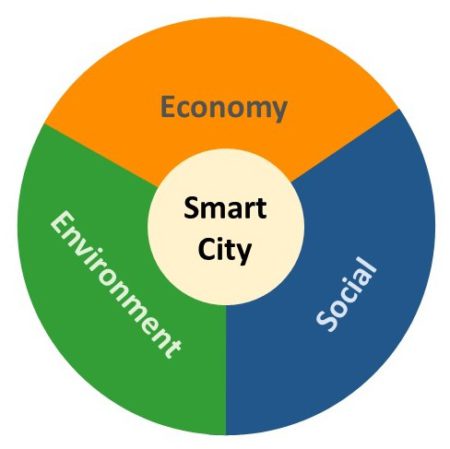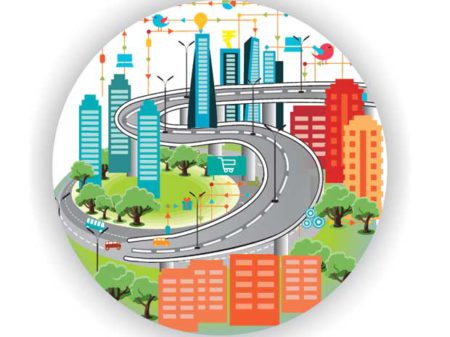What is a smart community?
A smart community is an interconnected city, community, or region that leverages the smart use of technologies to benefit its citizens, businesses, and service organizations for economic growth,  social benefits, and environmental sustainability. Smart community services are about maintaining and improving the livability of the community in the face of increasing pressures (budgets, population growth, global competition, etc.), while providing cost efficiencies and new revenue opportunities that improve fiscal sustainability.
social benefits, and environmental sustainability. Smart community services are about maintaining and improving the livability of the community in the face of increasing pressures (budgets, population growth, global competition, etc.), while providing cost efficiencies and new revenue opportunities that improve fiscal sustainability.
Smart city services are not just for “cities”. Communities and regions of all sizes can experience these pressures that put stress on economic development, public safety, infrastructure, energy and environment, and budgets. Read more about The Smart Community and why it matters.
What are smart community services?
There are many examples of smart community services – too many to provide a comprehensive list here. However, there are some illustrative examples and key concepts that can paint a picture of what smart services can mean for your community. Before delving into services examples, there are a few realities to recognize.
- Behind the scenes – Many of services may not be obvious or visible to residents, essentially operating behind the scenes. For example, most people take it for granted that the city ensures water quality and supply, provides effective policing, ensures adequate street lighting, etc.
- Detailed real-time data – A smart city collects information about operations (e.g. monitoring water quality, coordinating emergency response) to better plan and manage it services for the benefit of the community overall. This is also largely invisible to community members, but essential to enable the effective delivery of smart city services.
- Meaningful impacts – There are smart city services that are much more directly visible to and impactful on people in their daily lives, such as improved waste management, more efficient public transportation, household or business energy management, improved health and education services, etc.
Which services make sense for a city depends on addressing immediate needs or issues as well as meeting the city’s vision for the future. Understanding the needs and issues of community stakeholders is foundational to prioritizing the deployment of smart city services. A smart city strategy inherently requires a holistic approach that combines a focus on specific needs while interconnecting solutions, understanding that the whole is very much more than the sum of the parts.
Below are just a few real-world examples of smart city services that enhance public services, improve city management, reduce costs, and improve quality of life:
- Energy consumption – homes provided with smart energy meters, with incentives provided to those that actively reduce energy consumption.
- Adaptable street lighting (smart lighting) which allows municipalities to control the brightness of street lights, and lighting bike paths to improve public safety.
 Smart traffic management, where traffic is monitored in real time by the City and information about current travel time on certain roads is broadcast to allow motorists to determine the best routes to take. Integration of multiple smart city technologies through the implementation of smart traffic lights as buses run on routes designed to optimise the number of green lights. In addition, where an emergency is reported, the approximate route of the emergency vehicle is coordinated through the traffic light system, setting all the lights to green as the vehicle approaches through a mix of GPS and traffic management software, allowing emergency services to reach the incident without delay.
Smart traffic management, where traffic is monitored in real time by the City and information about current travel time on certain roads is broadcast to allow motorists to determine the best routes to take. Integration of multiple smart city technologies through the implementation of smart traffic lights as buses run on routes designed to optimise the number of green lights. In addition, where an emergency is reported, the approximate route of the emergency vehicle is coordinated through the traffic light system, setting all the lights to green as the vehicle approaches through a mix of GPS and traffic management software, allowing emergency services to reach the incident without delay.- Public spaces – sensor technology implemented in public park irrigation systems, where real time data is transmitted to gardening crews about the level of water required for the plants.
- Public transportation – managing a bus network based on data analysis of the most common traffic flows.
- Electric vehicle charging stations – Many smart cities are using agreements with energy providers to prepare for climate change, expand electric infrastructure, convert existing public vehicle fleets to electric cars, and create incentives for people to share rides when commuting.
- Smart energy – a distributed energy network across the city that would be monitored by IoT sensors, enabling the city an energy system that has enough capacity to receive and redistribute electricity to and from multiple energy sources
- Crime prevention – analysis of historical crime data to predict police requirements and maximise police presence where it is required, identifying places each day where property crimes are more likely to occur, and then placing police efforts on these regions when officers are not responding to any emergency.
What about technology?
Just as the community itself is a living and evolving interconnected ecosystem, smart community implementations need to be viewed as a holistic ecosystem enabled by underlying technologies. As an enabling platform, we call this the digital infrastructure, which consists of network communications capabilities through broadband and wireless technologies, as well as the smart devices and sensors that communicate over these networks. In addition, since data gathered through these devices and sensors is how the city collects information about itself, this data needs to be stored and intelligently analyzed in systems that are part of the digital infrastructure.
The “services” part of smart community services is the application layer that integrates and interconnects the “human” part of the smart community – the municipality and services organizations and the citizens and businesses they serve. Different services require different technologies to be included in the digital infrastructure, but the common element is the need for ubiquitous and unconstrained network communication capacity, through a combination of broadband wireline (fiber) and wireless networks.
For cities to move successfully into the future and benefit from smart community services, ensuring that they have the underlying broadband network is essential. In the scope of smart communities, broadband is much more than providing internet connectivity to people and businesses, although that in itself is part of being a smart community. Broadband is an essential component of the digital infrastructure.
Are you ready?
The rewards of developing and implementing your smart community strategy are immense in the context of maintaining the relevance and competitiveness of your community into the future. Doing this in a way that properly engages your city ecosystem can be daunting, but it is essential for establishing goals and priorities that can and should be addressed. Establishing a clear vision of smart services for your community around which all stakeholders will rally and that community leaders can promote is a first step.
Evaluating your priorities and readiness to move forward is equally important and should include input from those stakeholders and leaders. Through that process the potentially daunting task can be made tangible through focusing on the right priorities and ensuring that you are ready to move forward.
To support communities through hat process, SNG has developed a Smart Community Readiness Assessment designed to gather inputs from community stakeholders.




